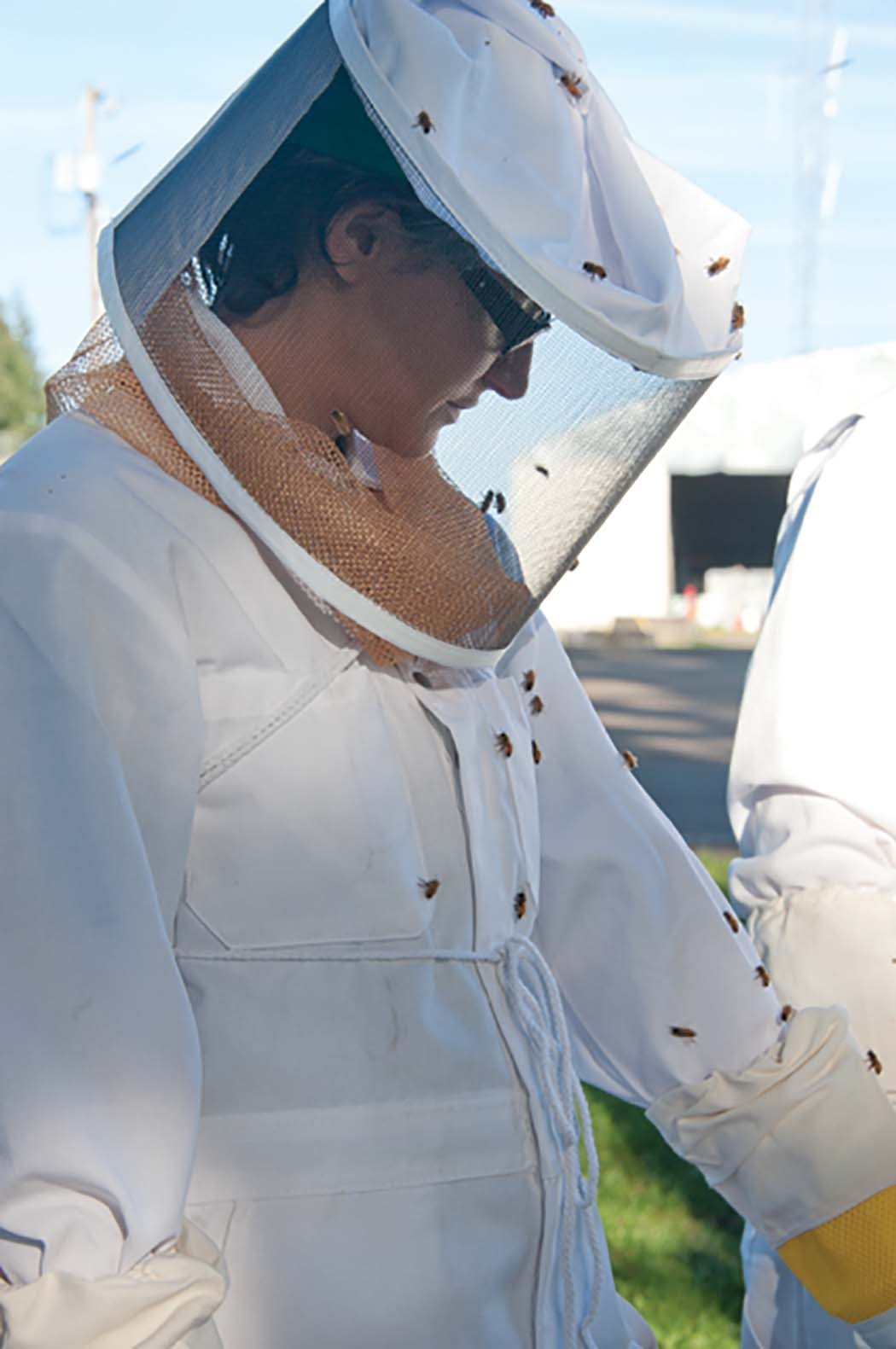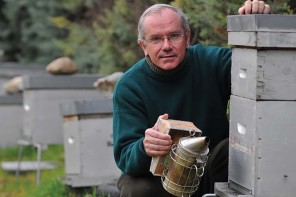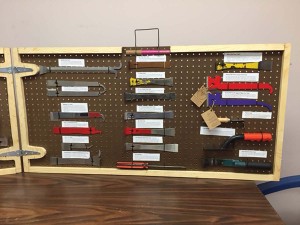by Nancy Hill
Crystal’s voice softens as she takes you back to the cold, rainy April night she and nine other women incarcerated at Oregon’s Coffee Creek Correctional Facility met the honey bees. “We didn’t know what to expect,” she says, her waist-length braid just visible when she tips her head to the side. Her deep brown eyes seem to be looking beyond the small table she sits at in the cramped office space at Coffee Creek’s minimum security facility.
Folding her hands on the metal tabletop, she shifts in her chair. “We were interviewed for the program the day before the bees came. Before we had time to ask questions, ten of us were waiting in a room almost always off limits to us. We’d been outcounted. Everything about the night was unusual.”
Outcounting is a term for the circumstance that occurs when an inmate doesn’t have to be in her bunk waiting for a head count, which happens five times a day. Crystal had been going through this regiment for nearly 15 years, and although she was as used to it as she was to the razor-wire fences surrounding the grounds in which she lived, the frequent counting was a reminder of her total lack of freedom.
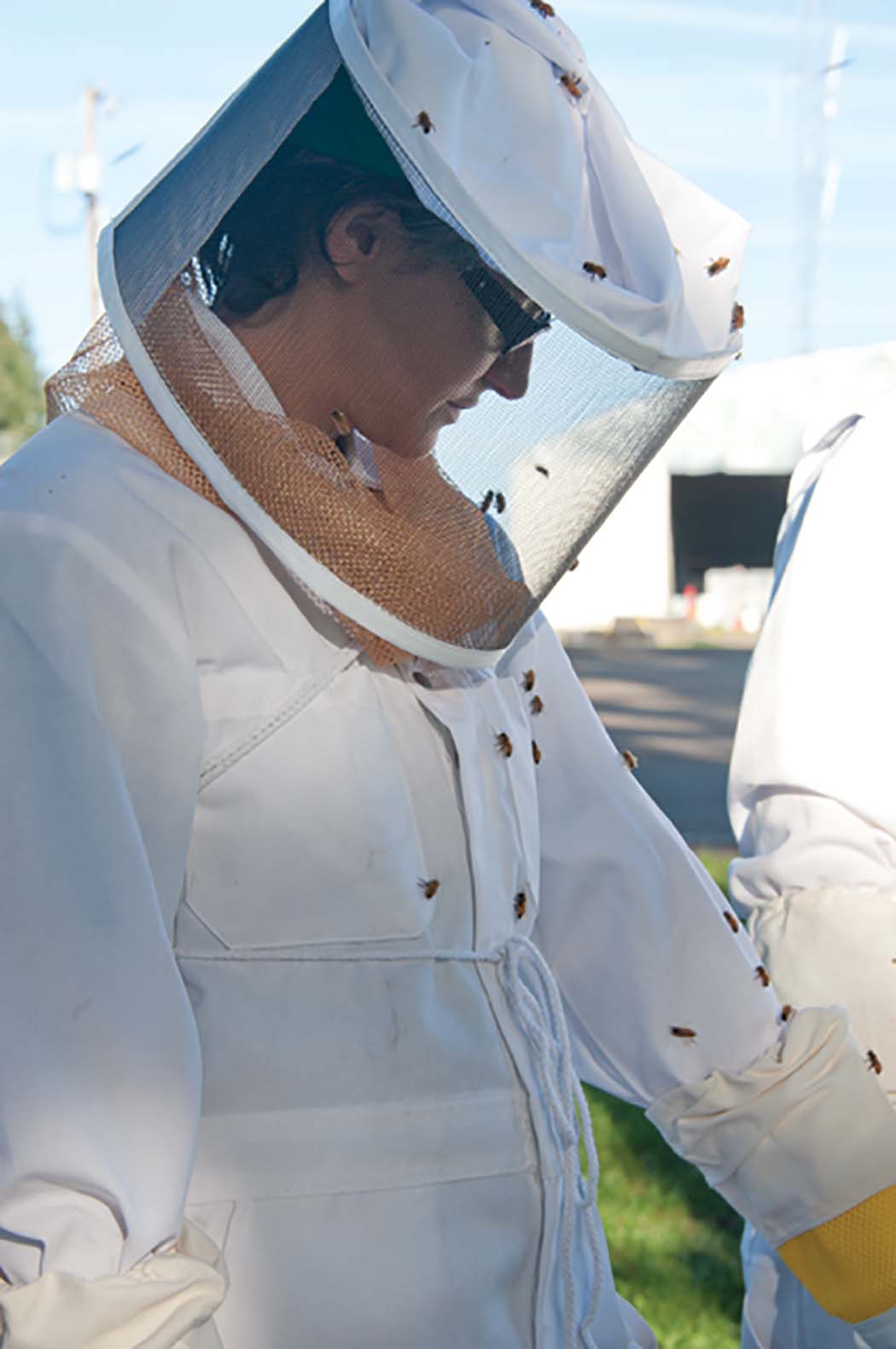
Crystal had doggedly participated in every program offered, but the other programs had been well established and she knew what to expect. The beekeeping program was different. She would be one of the first participants.
“I felt like a child about to enter a candy shop,” she recalls. “I had no idea what I would find, but I knew it would be amazing. A bee program in prison? That just didn’t happen.”
And yet 10 women were about to learn everything they needed to know to become beekeeping apprentices by the end of the year.
While the program was a mystery unfolding to the participants, prison officials had been working on it for months. Captain Chad Naugle, head of the sustainability program for Oregon’s prisons, worked tirelessly behind the scenes to bring the idea to fruition. “The program appealed to me because it had both a nature and a sustainability aspect to it. It also would provide offenders with a skill that could help them earn a living when they were released.” Moreover, it would augment the dwindling bee population while spreading an awareness of the seriousness of that threat to the environment.
Captain Naugle began meeting with prison officials, including Captain Marsha McCorkhill who has been a central figure throughout the program, and the beekeeping community who would work with inmates. Within a few months, a plan was in place to hold the program at one of Oregon’s men’s prison, but complications arose that prevented that.
Determined not to let this opportunity go, Captain Naugle met with Coffee Creek staff. They loved the idea. “Coffee Creek was an ideal place,” he says. “It went hand in hand with the garden and viola program several groups at Coffee Creek were already involved with.” In this program, women grow violas, which are on the endangered plant list, for the silverspot butterfly, which is on Oregon’s endangered species list. The beekeeping program was a natural fit with this and other habitat conservation programs in Oregon corrections.
Captain Naugle found internal funding sources, some beekeeping organizations donated supplies, and things flew into place. He advertised the program inviting women in the minimum security to submit an application to participate.
Crystal jumped at the opportunity. “When I first saw the flyer about a bee program, I thought it was a joke,” she recalls. “But I’m always open to new things, and I had learned at Coffee Creek that any kind of education leads to freedom, so I sent a kyte to see if I could participate.” Her kyte – a Coffee Creek term for a letter—was one of 10 the prison received.
The day after the application process closed, all applicants were interviewed. Everyone was accepted. While each woman was eager to participate, their reasons for applying were as varied as the roles of bees in a hive. One wanted to face her fear of bees. One had always loved bees and wanted to learn more about them. One had family members who had worked with bees.
Finally, it was time to don the beekeeping suits. Crystal remembers this fondly. “We nearly jumped into them we were so excited. One of the staff told us we looked like giant marshmallows.”
Suited up, the women crowded into a van to take them to the hives. “It seemed to take forever to get to the bees even though it was probably a 30-second drive,” Crystal says with a laugh. “But we were out of our unit and headed into unknown territory. Anticipation filled the van. Through the rain I could make out huge, beautiful trees and wide open spaces. We wouldn’t be behind a fence.”
The women found a gathering of people waiting for them. Crystal’s eyes tear as she remembers how it felt to have so many people there to meet them. Among those greeting them were high-ranking prison officials; a retired assistant superintendent and his wife; beekeepers Bunny Cramer-Carter and Bruce Roller; and Captains McCorkhill and Naugle.
“All of us were stunned that so many people had come out on this freezing night to meet us. I remember Bruce shaking everybody’s hand. When you’re treated like that in this environment, it’s very empowering.”
When Bruce Roller heard about the Coffee Creek program, he wanted to give back. He had been a beekeeper since 2009. He started his first hive when he heard about problems with the bee population. “The only thing I could do to help was to put more bees into the world.”
While Bunny Cramer-Carter and Ann Murray would teach the participants in the classroom, Bruce would work alongside the women with the hives. His first job? Teach the women about adding a queen to a hive.
“As soon as we got there, we saw three hives,” Crystal says, “but we couldn’t see any bees. We had to put our veils on first. They were the old-fashion kind that you had to tuck all around your chin and cinch it and then tie it around your body. Finally we got that done and then put on our gloves.”
The time to take out the queen had come. The women gathered under an awning, which was necessary to keep the bees from getting wet.
“None of us said a word while Bruce explained he would put a marshmallow in her cage, pull out the plug, and replace it with a marshmallow. By the time she ate through it, the other bees in the hive would be used to her scent,” Crystal explains.
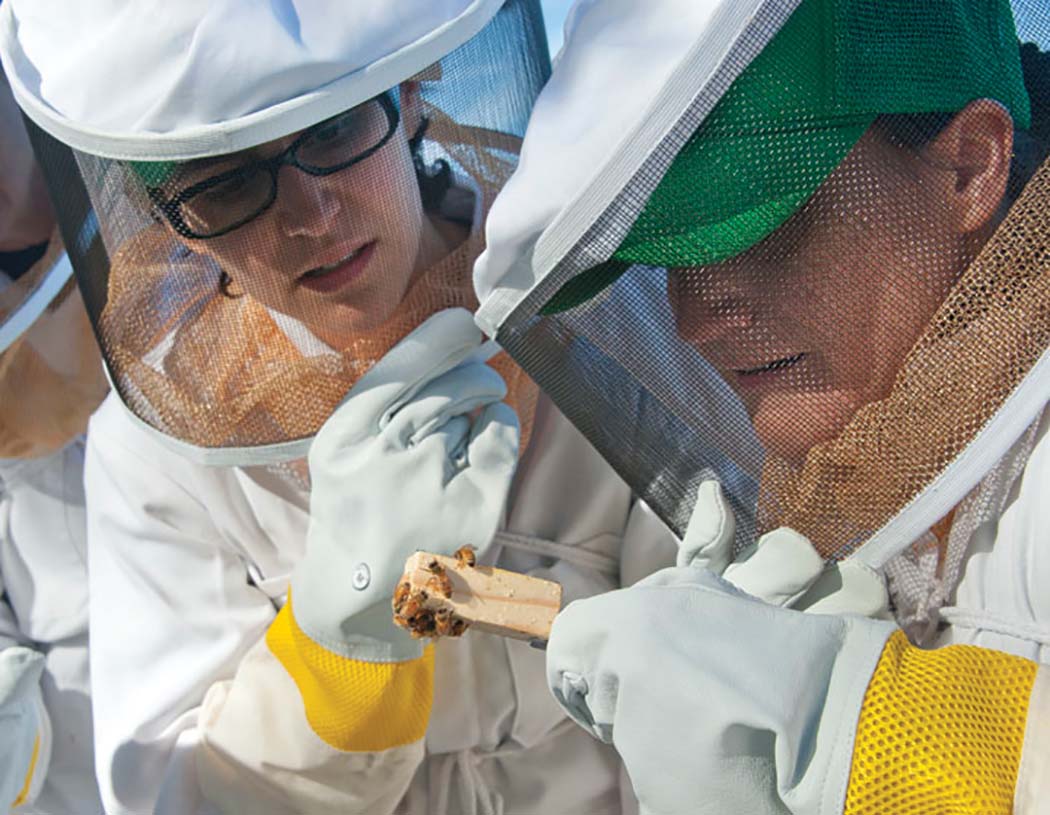
The women watched enthralled. But what came next was even more fascinating. “The bees were in a cage flying around. We had to hit the cage a little and then shake them into the box,” Crystal says.
Her eyes shine at the memory, and she lowers her voice. “Except for the rain, it was completely quiet. Then we heard the buzzing. It was so calming and peaceful, like nothing you’ve heard before. All we hear in here are doors slamming and keys jangling and locks closing. The sound of bees buzzing was soothing to our souls.”
Bruce says that when he saw the women’s enthusiasm, he had little doubt the program would be fruitful for everyone involved. He was never disappointed. From the first night, the women were fully engaged, although some were initially a bit nervous. Soon, though, their fascination with the bees was evident. Bruce states that every time the women came to work with the bees, they had more questions and studied the hives for any changes that could mean problems. They learned the rolls each bee played and could quickly identify them. Some even learned to pet the bees.
“One of the things that always makes the women smile is watching a bee work its way out of a cell. Seeing a bee born amazes them,” Bruce reports.
Classroom learning, a key component of the program, wasn’t nearly as exciting at first. As Bunny, who co-teaches with beekeeper Ann Murray, recalls, “The women seemed a little bored, but when they were able to work with hives, they got seriously interested. In class they began challenging what they were learning. They wanted to know what any unusual activity they’d seen in their hives meant.”
The group had three hives. Initially, the hives were unadorned, nameless white boxes, but the women soon painted them in colorful designs and named the hives New Beeginnings, Beelieve, and Mizzbeehavin.
Bunny Cramer-Carter reports she has witnessed changes not only in the women themselves but also in their relationships with their families. “It brings family together. Most of the women talk to their families about the bees, and families participate by sending books. Some have families who’ll give them space for hives when they get out.”
She enjoys working with the women. “Some people are against helping the women because they have judged them, but if they spent time with them, I think they’d change their minds.”
Co-teacher Ann Murray is an artist. She has a minor in criminal justice, and while she taught art in a juvenile correctional facility, she’d never worked with incarcerated adults.
“Programs like this lower the recidivism rate,” she says. “Again and again I see women learning life lessons from the bees. They see the bees communicate and know how important that is to keep the hive healthy. They see that working together is critical to survival.” Ann says they learn what it takes to build a community, and they see altruism in action. “This will stay with them the rest of their lives.”
Like Bunny, Ann thoroughly enjoys working with the women in Coffee Creek. “Being a part of this program makes my day. When I come back from class, I feel good for me but also for the bees because some of the women will go on working with them. They say this is the best thing they’ve ever done, and I believe them. We’re there to bring sunshine into their lives, and then they bring it into ours.”
Toward the end of the year-long class, the participants create a business plan. Bunny explains that she and Ann give the beekeepers-in-training a hypothetical amount of money and catalogs to help them create their plans, which range from having a single hive to setting up and running a complex commercial business.
Everyone in the program passed their apprenticeship class at the end of the year. Eight of the women who participated in the first program have been released. Crystal is now participating in the second program and plans to have a bee business when she is released in June.
“One of the reasons I love the bees so much is because they survive. They depend on each other, and that’s something I’m developing in my life. I’m learning I can turn to others for help. Coming from my background, I didn’t have that before. I was alone, and you can’t survive that way. You think you can, but you can’t.”
Crystal has been part of two different groups of women learning beekeeping. She stresses that her love for the bees and the lessons she has learned from them is something everyone in the program shares. “We learn together, we grow together, and everything I have said here about the bees and what they mean, is true for every one of us. They change our lives. They give us way, way more than honey.”
From the time the program was first proposed, Coffee Creek staff knew the lessons the participants would absorb would extend far beyond the care of bees. They would learn about the environment and sustainability and acquire new skills they could use when they were released from prison. There were other intangibles that were difficult to predict.
Captain McCorkhill, who oversees the minimum security facility, sees tremendous value in the program. “The biggest difference is seeing women stopping and talking to each other about it. They know the bees’ favorite color is purple. They educate each other. This is about being pro-social instead of criminal.
“They have more confidence. Maybe they’ve been told they were incompetent, failures. Some were scared, but they’ve overcome their fears. Women come here because of wrong choices and bad decisions, so I’m looking for healthy things they can carry on when they’re back in the community. Maybe this program will give them a business or a hobby they can go to instead of committing a crime.”
Captain McCorkhill went through the program herself, learning along with the women. She, too, took and passed the apprenticeship test. “When they see me out there they call me the bee lady. They always have a lot of questions, so it breaks the barrier down. They’re not looking at the uniform, they’re looking at me as a person.”
The program also gives the women a new way to interact with staff, who are curious about the bees themselves. Instead of watching the women for rule infractions, the staff stops to talk to them about the bees.
The women in the current program express the same enthusiasm as Crystal. Christina had grandparents who kept bees. “I like the people in the beekeeping environment. The program gives us some self-worth. Some people come from crazy backgrounds. They do something good here, and they see that they can do good things. Knowledge is power, and nobody can take this away from us. The program makes us feel normal in such a panicky environment.”
A participant who is also named Crystal reports that working with the bees has helped her with her child. “This is something I can pass on to her. I love the fact that it’s women power in the hive. The girl bees take on all sorts of roles.”
Isabelle, who had no interest in bees before the program, now plans to have four to eight hives when she gets out. “This program awakened a sense of personal responsibility – what I eat, how I interact with the earth. One thing about working with bees is seeing how the population is decreasing and how humans impact that and what we can do to help.”
Sara was stung by hornets when she was six and so feared bees. She’s overcome that now. She focuses a great deal on the health-related aspects of bees. “My goal is to learn about bees and organic gardening so when I get out, I can advocate for healthy living.” She also likes that her 13-year-old daughter actually acknowledged that she knows something. “She listened to me talk about the bees and then said, ‘You actually know what you’re talking about.’” She laughs, then adds, “When I get out, this is something we’ll do together.”
The program is now in its second year. A second program has been set up in another Oregon correctional facility, and as word of the program’s success buzzes around, others have also expressed interest in creating a similar program.
“The bees teach us about community,” Crystal says. “We need to help each other, to work together. And that’s one of the things we’re all learning to do.”




